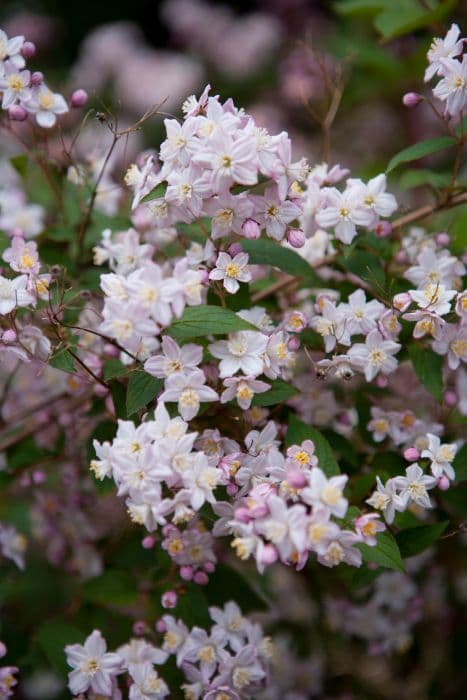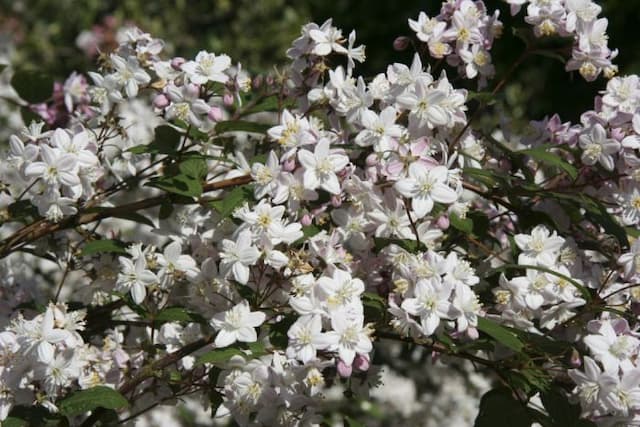Bigleaf Hydrangea Hydrangea macrophylla 'Ami Pasquier' (H)

ABOUT
The Hydrangea 'Ami Pasquier' is a striking ornamental shrub known for its large clusters of flowers which can range in color from deep pink to violet, depending on the acidity of the soil. Each bloom is made up of numerous small florets that together form a rounded, pom-pom like shape. These clusters are often so abundant that they cover the shrub from early to late summer, creating a dramatic floral display. The leaves of the 'Ami Pasquier' hydrangea are glossy with a deep green hue, providing a lush backdrop for the vivid flowers. The texture of the leaves is smooth, and their edges have a gentle, serrated pattern. This hydrangea's branches and stems are sturdy, supporting the weight of the large flower clusters. Overall, the plant has a bushy appearance with a generous spread of both foliage and blooms, making it a standout in any garden.
About this plant
 Names
NamesFamily
Hydrangeaceae
Synonyms
Bigleaf Hydrangea, French Hydrangea, Lacecap Hydrangea, Mophead Hydrangea, Penny Mac, Hortensia
Common names
Hydrangea macrophylla 'Ami Pasquier'
 Toxicity
ToxicityTo humans
Hydrangeas, including the Hydrangea macrophylla 'Ami Pasquier', contain cyanogenic glycosides, which can release cyanide when chewed or digested. Ingestion of hydrangea parts, particularly the leaves and flowers, can lead to symptoms of poisoning. These symptoms may include gastrointestinal upset, such as vomiting and diarrhea, dizziness, and in severe cases, confusion and seizures due to the cyanide's effect on oxygen utilization by the body's cells. It is relatively rare for humans to experience serious poisoning from hydrangeas, as substantial quantities need to be consumed to cause severe toxicity.
To pets
Hydrangeas are also toxic to pets, including dogs and cats. Similar to their effects in humans, the plant parts contain cyanogenic glycosides, which can be harmful when ingested. If a pet consumes hydrangea leaves or flowers, they might experience symptoms such as vomiting, diarrhea, lethargy, and in some cases, more severe signs like depression and cyanosis (bluish discoloration of the mucous membranes due to low oxygen levels in the blood). It is important for pet owners to prevent their animals from accessing and ingesting parts of the hydrangea plant to avoid the risk of poisoning.
 Characteristics
CharacteristicsLife cycle
Perennials
Foliage type
Deciduous
Color of leaves
Green
Flower color
Red
Height
4-6 feet (1.2-1.8 meters)
Spread
4-6 feet (1.2-1.8 meters)
Plant type
Shrub
Hardiness zones
6
Native area
Japan
Benefits
 General Benefits
General Benefits- Enhances Landscape Aesthetics: The vibrant colored blooms of the hydrangea can be a focal point in any garden, adding visual interest with its lush foliage and large flowers.
- Attracts Pollinators: Hydrangeas attract bees and butterflies, which help pollinate gardens, supporting biodiversity.
- Versatile Garden Use: Hydrangeas can be planted in flower beds, borders, or as a standalone feature in a garden. They can also be grown in containers.
- Seasonal Interest: It offers a long flowering season from late spring through summer, providing color and interest for an extended period.
- Ease of Care: With proper planting and minimal maintenance, hydrangeas thrive easily, making them suitable for gardeners of all skill levels.
- Suitable for Coastal Areas: The plant is tolerant of coastal conditions, which means it can be grown in gardens near the sea that may have salty soils.
- Can Provide Cut Flowers: The blooms are ideal for cutting and creating floral arrangements inside the home.
- Adaptable to Various Soils: Although they prefer well-drained, moist soil, hydrangeas are quite adaptable and can tolerate a range of soil types.
- Color Variation with Soil pH: The color of hydrangea flowers can change according to the pH level of the soil, providing an interesting way to experiment with garden chemistry.
 Medical Properties
Medical PropertiesThis plant is not used for medical purposes.
 Air-purifying Qualities
Air-purifying QualitiesThis plant is not specifically known for air purifying qualities.
 Other Uses
Other Uses- Colorant: Hydrangeas can be used to naturally dye fabrics or paper, with the blooms offering a range of colors depending on the pH of the water used during the dyeing process.
- Ornamental Art: Dried hydrangea flowers can be arranged in shadow boxes or picture frames to create lasting botanical artwork.
- Culinary Garnish: Fresh or dried hydrangea flowers can add a touch of elegance to desserts and cocktails, though they are not edible and should be used for decoration only.
- Theme Gardens: Hydrangea enthusiasts sometimes design entire gardens around different cultivars to showcase variations in color and form.
- Mood Lighting: Placing LED lights among hydrangea blooms in the evening can create a magical and enchanting glow in the garden.
- Potpourri: The dried petals and leaves can be added to potpourri mixes for their aesthetic appeal and to add bulk.
- Wreaths and Swags: Durable hydrangea flower heads can be incorporated into wreaths and swags for seasonal decorations.
- Wedding Decor: Due to their lush and full appearance, hydrangeas are often integrated into wedding bouquets, centerpieces, and venue decorations.
- Photography Prop: The ample and vibrant blooms make a popular prop or backdrop for spring and summer photography shoots.
- Craft Projects: Kids and adults alike can use the flowers for various craft projects, including pressing for bookmarks or creating floral suncatchers.
Interesting Facts
 Feng Shui
Feng ShuiHydrangeas are often associated with gratitude, grace, and beauty in Feng Shui, reflecting a peaceful energy and replenishing vibes to any area of a home or garden. To harness their positive qualities, place Hydrangeas in the east side for family harmony and health or in the southeast sector to enhance wealth and prosperity.
 Zodiac Sign Compitability
Zodiac Sign CompitabilityHydrangeas are not used in astrology practice.
 Plant Symbolism
Plant Symbolism- Gratitude for being understood: In Japan, the hydrangea came to symbolize an apology or gratitude for being understood, often given after a receiver has shown understanding towards the giver.
- Heartfelt emotions and love: Because of their full, rounded bloom, hydrangeas embody abundance and sincerity, making them an emblem for expressing deep and heartfelt emotions, including love.
- Vanity or boastfulness: In Victorian times, gifting hydrangeas could sometimes represent vanity or boastfulness due to their showy and abundant flowers.
- Fragility and gratitude: The delicate nature of the hydrangea bloom can represent both fragility and gratitude, capturing the ephemeral and appreciative aspects of many circumstances.
- Abundance and prosperity: The lavish, full blooms and rich foliage of the hydrangea are often associated with abundance and prosperity, reflective of its lush and bountiful appearance.
 Water
WaterThe Bigleaf Hydrangea prefers consistently moist soil, so water it deeply once a week, providing about 1 gallon of water for each session during the growing season. Increase the frequency to twice a week during periods of extreme heat or if it's planted in a particularly sunny spot. Ensure the soil has good drainage to prevent root rot. During the fall and winter, reduce watering to match the plant’s reduced water needs as it goes dormant.
 Light
LightBigleaf Hydrangeas thrive in locations where they receive morning sun and afternoon shade. The ideal spot for this hydrangea is an eastern-facing location that protects it from the intense heat of the late day sun. Too much direct sunlight can lead to leaf scorch, while too little can reduce blooming.
 Temperature
TemperatureBigleaf Hydrangeas prefer temperatures between 65°F and 75°F for optimal growth. They can tolerate a minimum temperature of around 50°F, but frost can damage buds and flowers. The maximum temperature it can handle without stress is about 85°F; above this, the plant may require additional shading and water.
 Pruning
PruningFor Bigleaf Hydrangeas, pruning is generally done to shape the plant and remove dead or broken stems. The best time to prune is after the shrub has finished blooming in mid to late summer. Since this hydrangea variety blooms on old wood, it’s essential not to prune too heavily or cut back last year’s growth to ensure next season's blooms.
 Cleaning
CleaningAs needed
 Soil
SoilThe best soil mix for Bigleaf Hydrangea is well-draining and rich in organic matter, with equal parts garden soil, peat moss, and perlite. It prefers a soil pH of 5.2 to 5.5 for blue flowers and a pH above 6 for pink flowers.
 Repotting
RepottingBigleaf Hydrangea should be repotted every 2 to 3 years or when it becomes root-bound to encourage proper growth and blooming.
 Humidity & Misting
Humidity & MistingBigleaf Hydrangea thrives in moderate to high humidity levels, ideally between 50% and 60%, as it mimics the plant's native environment.
 Suitable locations
Suitable locationsIndoor
Provide bright, indirect light and keep humidity high for indoor Bigleaf Hydrangea.
Outdoor
Place in morning sun, afternoon shade, and shelter from harsh winds for outdoor Bigleaf Hydrangea.
Hardiness zone
6-9 USDA
 Life cycle
Life cycleThe life of Hydrangea macrophylla 'Ami Pasquier', commonly known as bigleaf hydrangea, begins with seed germination, where the seed requires moist, well-drained soil and appropriate temperatures to sprout. As a juvenile, the hydrangea rapidly develops a root system and foliage, entering a vegetative state where it focuses on leaf growth and root expansion. The plant then transitions into the flowering stage, producing large, showy mophead or lacecap blooms which can be pink, blue, or purple, depending on soil pH. After pollination, the hydrangea sets seeds in the late summer or fall, completing its reproductive cycle. In winter, the hydrangea enters dormancy, with aerial parts often dying back in colder climates while the roots remain alive, ready for new growth in spring. Throughout its life, which can span several years, the hydrangea experiences repeated annual cycles of growth, flowering, seed setting, and dormancy.
 Propogation
PropogationPropogation time
Spring-Early Summer
Propogation: The Hydrangea macrophylla 'Ami Pasquier', commonly known as the bigleaf hydrangea, is most successfully propagated through stem cuttings. The best time to take cuttings is in late spring or early summer when the plant's new growth is still soft and green, known as semi-hardwood cuttings. To propagate, a gardener would cut a 4 to 6 inch (about 10 to 15 cm) length of stem that includes several leaves and at least one node, the point on a stem from which the leaves or branches grow. The lower leaves are removed, and the cut end is dipped in rooting hormone to encourage root development. This cutting is then placed in a well-draining potting mix, ensuring at least one node is beneath the soil surface. The pot is kept in a warm, humid environment with indirect light until roots establish which typically takes several weeks. Once rooted, the new hydrangea plant can be transplanted to a more permanent location.








![Hydrangea [Early Sensation]](/_next/image?url=https%3A%2F%2Fplants-admin.emdemapps.com%2Fimages%2Fplants%2F%2Fimages%2F604b6150338db.png&w=640&q=75)
